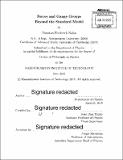Forces and gauge groups beyond the standard model
Author(s)
Kahn, Yonatan Frederick
DownloadFull printable version (14.26Mb)
Other Contributors
Massachusetts Institute of Technology. Department of Physics.
Advisor
Jesse Diaz Thaler.
Terms of use
Metadata
Show full item recordAbstract
The discovery of the Higgs boson in 2012 completed the particle content of the Standard Model, but brought into sharp relief two outstanding problems: why is the Higgs so light, and what is the identity of 80% of the matter content of the universe? Neither appears to have an answer within the Standard Model. This thesis attempts to address these problems with the introduction of new forces and gauge groups. I investigate a model where dark matter interacts through a new massive U(1) gauge boson which kinetically mixes with the photon, and show how this model can be tested at neutrino experiments. Supersymmetry may explain the smallness of the Higgs mass compared to the Planck scale, but reconciling the measured value of 126 GeV with the absence of super-partners at colliders is difficult. By gauging various global symmetries of the Standard Model, I show that a variant of Higgsed gauge mediation called auxiliary gauge mediation can provide acceptable supersymmetric spectra. Finally, the astrophysical dark sector may be complicated, with many kinds of allowed interactions, and I describe techniques to diagnose the presence of dark matter at direct-detection experiments independent of its velocity distribution.
Description
Thesis: Ph. D., Massachusetts Institute of Technology, Department of Physics, 2015. Cataloged from PDF version of thesis. Includes bibliographical references (pages 145-162).
Date issued
2015Department
Massachusetts Institute of Technology. Department of PhysicsPublisher
Massachusetts Institute of Technology
Keywords
Physics.